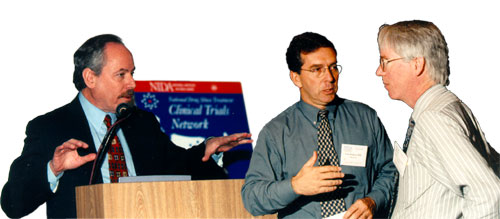NIDA's National Drug Abuse Treatment Clinical Trials Network (CTN) is up and running. Seven research-based drug abuse treatment protocols are being tested under real-world treatment conditions by the network's 6 pioneering regional research centers in collaboration with more than 35 community treatment programs (CTPs). Approximately 3,000 drug abuse patients are expected to participate in this first wave of clinical trials of promising new pharmacological and behavioral drug abuse treatments.
"The CTN is definitely not business as usual," says Dr. Betty Tai, who directs NIDA's CTN Office. In these studies, researchers and practitioners are breaking new ground by working together to see whether and how treatments that are effective under carefully controlled conditions can be adapted and applied effectively with diverse patient populations in a variety of treatment settings, she says. "We expect that protocols that work under these real-world conditions will quickly become the standard of care for physicians, treatment programs, and their patients," she says.
 Dr. Betty Tai, Clinical Trials Branch, NIDA; Dr. Robert Forman, University of Pennsylvania, Delaware Valley Node; and Paul Nagy, Duke Addictions Program, North Carolina Node, discuss drug abuse treatment at the CTN meeting in October.
Dr. Betty Tai, Clinical Trials Branch, NIDA; Dr. Robert Forman, University of Pennsylvania, Delaware Valley Node; and Paul Nagy, Duke Addictions Program, North Carolina Node, discuss drug abuse treatment at the CTN meeting in October. Goals of the Protocols
The CTN's Steering Committee selected the first treatment concepts for testing using three main criteria-solid scientific evidence of efficacy, ease of implementation, and potential to improve public health, Dr. Tai says. Three broad pharmacological and behavioral treatment research concepts were approved from which CTN protocol development teams produced seven treatment protocols for implementation.
Two pharmacological protocols are studying whether buprenorphine/naloxone (BUP/NX) would be more effective in detoxifying opiate-dependent patients than clonidine, a medication that has been used to detoxify opiate addicts. A related protocol is studying the relative effectiveness of different BUP/NX dosing regimens in detoxifying opiate-dependent treatment patients. BUP/NX is a new medication that is nearing FDA approval for treating opiate addiction. Detoxification, the medically supervised withdrawal from an addicting drug on which a patient is physically dependent, represents the first step in treating opiate addiction. Following detoxification, patients are treated with a variety of behavioral and pharmacological approaches in many different treatment settings.
The primary objective of the BUP/NX studies is to evaluate the medication's usefulness in detoxifying opiate addicts in both inpatient and outpatient community treatment settings and to determine the most effective dosing regimens. The lead investigator for these studies, Dr. Walter Ling from the University of California, Los Angeles, directs the CTN's Pacific Region Node. A total of 1,080 patients from 14 CTPs in California, Oregon, New York, Pennsylvania, Connecticut, Virginia, and Maryland are expected to participate in these 3 studies.
Two cognitive treatment protocols are adding motivational enhancement therapy (MET) to standard drug abuse treatment. MET is a brief, nonconfrontational treatment in which a clinician seeks to increase patients' commitment to reducing their drug abuse by heightening their awareness of the harmful personal consequences of that use. In one protocol, a therapist delivers MET in three individual therapy sessions during the first 3 weeks of treatment. In the second protocol, called motivational interviewing, therapists use MET techniques only in the intake interview given to patients when they enter treatment.
Both MET protocols are trying to determine if patients who are treated with motivational enhancement techniques stay in treatment longer and reduce their drug use more than patients who receive standard treatment alone. The principal investigator for these studies is Dr. Kathleen Carroll of Yale University in New Haven, Connecticut, who directs the CTN's Southern New England Node. It is anticipated that 1,100 patients from 11 CTPs in California, Connecticut, Virginia, Pennsylvania, Oregon, and New York will participate in these 2 studies.

 CTN researchers, treatment providers, and NIDA staff met in Los Angeles in October to discuss new treatment protocols and related issues. Top from left: NIDA Director Dr. Alan I. Leshner; Dr. Ivan Montoya, Clinical Trials Branch, NIDA; Dr. Dennis McCarty, Oregon Health Sciences University, Northwest Node. Bottom - Kevin McEneaney, Therapeutic Communities of America, Inc.; Allan Bray, Self Help Addiction Rehabilitation, Inc., Great Lakes Node; and Dr. Kathleen Carroll, Yale University, Southern New England Node.
CTN researchers, treatment providers, and NIDA staff met in Los Angeles in October to discuss new treatment protocols and related issues. Top from left: NIDA Director Dr. Alan I. Leshner; Dr. Ivan Montoya, Clinical Trials Branch, NIDA; Dr. Dennis McCarty, Oregon Health Sciences University, Northwest Node. Bottom - Kevin McEneaney, Therapeutic Communities of America, Inc.; Allan Bray, Self Help Addiction Rehabilitation, Inc., Great Lakes Node; and Dr. Kathleen Carroll, Yale University, Southern New England Node.The last two protocols are assessing the benefit of adding a behavioral treatment called motivational incentive (MI) therapy to standard treatment. One protocol is being tested with patients in methadone clinics and the other in drug-free clinics. MI therapy offers patients tangible rewards for remaining drug free. Patients are given the chance to draw for prizes whenever tests indicate they have not used cocaine, amphetamines, methamphetamine, or alcohol. Abstinent patients can win prizes that range from small items such as candy bars and sodas all the way up to larger items, such as clothing, radios, and TVs. Patients have a better chance of winning smaller prizes than larger ones, but the longer they remain abstinent the more chances they get to win.
The primary objective of the MI protocols is to determine if offering tangible incentives for remaining drug free can keep patients in treatment longer and reduce their drug abuse more than standard treatment alone does. Dr. Maxine Stitzer of The Johns Hopkins University School of Medicine in Baltimore, Maryland, and the CTN's Mid-Atlantic Node is the lead investigator for these studies. A total of 800 patients from 5 metha-done treatment programs and 6 drug-free clinics in California, Connecticut, Maryland, New York, and Pennsylvania are expected to participate in these 2 studies.
From Protocol to Practice
"We wanted this first wave of protocols to be easy to implement and transfer into community practice," Dr. Tai says. One of the ways the protocols are accomplishing this is by simply adding the therapy being tested to the standard treatment normally used in participating CTPs. Patients in the study are assigned randomly to either the enhanced treatment or standard treatment alone. If a study establishes that patients do better with the enhanced treatment than the standard treatment alone, CTPs can simply use the protocol to add the new treatment to standard treatment as needed, Dr. Tai says.
CTN participants modified research-based treatments to enable them to be sustained in practice, says Dr. Tai. For example, the protocols to implement the MI therapy in the CTPs set the total value of rewards that patients can accumulate for staying drug free considerably lower than the total used in research settings. Researchers initially felt that higher rewards might be needed to provide sufficient incentive for drug abuse patients to remain abstinent. However, practitioners were concerned that such awards would prove too costly for their programs. After much negotiation, the CTN's Steering Committee, which is made up of both researchers and CTP representatives, agreed on a middle ground that kept the maximum value of incentives within a range that CTPs felt they could afford. The bottom line was that CTPs would not have been able to support more costly incentives, no matter how well they worked.
"The CTN has made a very good start towards allowing research and clinical practice to impact one another," says Albert L. Hasson, administrative director of the Matrix Institute on Addiction, an outpatient drug-free clinic in the Los Angeles area that is participating in the CTN. "The researchers have ideas about how the research should be done based on what has worked in controlled settings. In turn, the CTPs have ideas about how the research should be adapted and integrated into existing treatment settings to best suit the needs of the programs and the patients they serve.
"Participating in a project of this magnitude has been invaluable for us," says Mr. Hasson, who also serves on the CTN's Steering Committee. "To have input into the direction the research will take has enabled our organization to become part of something that could very well shape the future of drug treatment for years to come."
